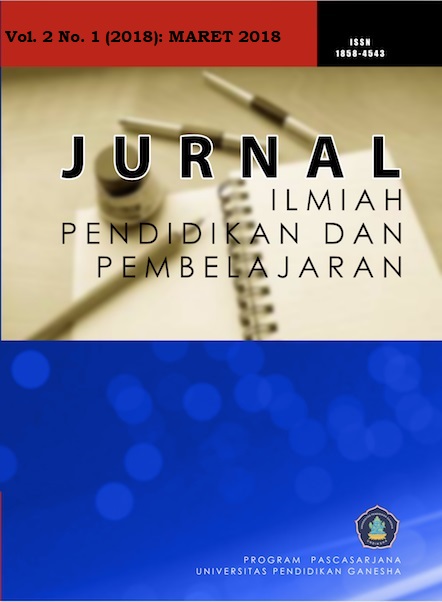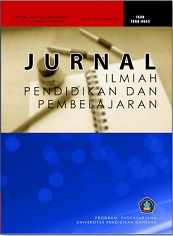BERPIKIR KRITIS SISWA DALAM PENYELESAIAN MATEMATIKA DITINJAU DARI PERBEDAAN TIPE GAYA KOGNITIF REFLEKTIF DAN IMPULSIF
DOI:
https://doi.org/10.23887/jipp.v2i1.13279Abstract
The essence of mathematics learning is the ability to solve math problems. Differences in ability, one of which is the suspect cognitive style. Based on the cause of the necessary mathematical problems of the students, cognitive style consists of a type of reflection and impulsive. So that the focus of this research is to analyze students' critical thinking skills in solving mathematical problems based on different types of reflective and impulsive cognitive style. Causal-comparative studies are needed to analyze the problem. The population of this study is composed of students of class VII SMPN 1 Susukan Cirebon. While the sample search uses the intentional sampling technique with the number of research samples 31 students. The technique of data collection using the Cognitive Style TMF test (correspondence familiar figures Test) and description Test (essay) Mathematics of critical thinking. The hypothesis test used is the t-test (T-test for independent samples). The results of the research show that the distribution of cognitive styles of students at SMPN 1 Susukan Cirebon, dominated by reflective-type cognitive style students (74% of students), while a small part of the students type of impulsive cognitive style (26% of students ). Critical thinking ability of reflective type students of cognitive style is better than the type of impulsive cognitive style studentsReferences
Allinson, C. W., & Hayes, J. (1996). The cognitive style index: A measure of intuition‐analysis for organizational research. Journal of Management studies, 33(1), 119-135.
Bailin, S., Case, R., Coombs, J. R., & Daniels, L. B. (1999). Conceptualizing critical thinking. Journal of curriculum studies,31(3), 285-302.
Block, J., Block, J. H., & Harrington, D. M. (1974). Some misgivings about the Matching Familiar Figures Test as a measure of reflection-impulsivity. Developmental Psychology, 10(5), 611.
Creswell, J. W., & Creswell, J. D. (2017). Research design: Qualitative, quantitative, and mixed methods approaches. Sage publications.
Daraini, R. (2012). Pengaruh Pembelajaran Berbasis Multimedia dan Gaya Kognitif Terhadap Kemampuan Pemecahan Masalah Matematika. Jurnal Teknologi Pendidikan, 5(02), 236-243.
Etikan, I., Musa, S. A., & Alkassim, R. S. (2016). Comparison of convenience sampling and purposive sampling. American Journal of Theoretical and Applied Statistics, 5(1), 1-4.
Firestone, P., & Douglas, V. I. (1977). The effects of verbal and material rewards and punishers on the performance of impulsive and reflective children. Child study journal, 7(2), 71-78.
Gouba, L. (2008). The importance of mathematics in everyday life. African Institute for mathematical Sciences, 6.
Hiebert, J., & Lefevre, P. (1986). Conceptual and procedural knowledge in mathematics: An introductory analysis. Conceptual and procedural knowledge: The case of mathematics, 2, 1-27.
Ibad, M. (2011). Eksperimentasi Pembelajaran Matematika Metode Kooperatif Tipe Student Teams Achievement Divisions (STAD) dan Metode Kooperatif Tipe Numbered Heads Together (NHT) Ditinjau dari Gaya Belajar Siswa (Doctoral dissertation, Universitas Sebelas Maret).
Kubiszyn, T., & Borich, G. (2015). Educational testing and measurement. John Wiley & Sons Incorporated.
Najichun, M., & Winarso, W. (2017). Hubungan Persepsi Siswa tentang Guru Matematika dengan Hasil Belajar Matematika Siswa. Jurnal Psikologi, 15(2), 143-150.
O'Mahony, M. (2017). Sensory evaluation of food: statistical methods and procedures. Routledge.
Peter, E. E. (2012). Critical thinking: Essence for teaching mathematics and mathematics problem solving skills. African Journal of Mathematics and Computer Science Research, 5(3), 39-43.
Riding, R., & Cheema, I. (1991). Cognitive styles—an overview and integration. Educational psychology, 11(3-4), 193-215.
Riding, R., & Rayner, S. (2013). Cognitive styles and learning strategies: Understanding style differences in learning and behavior. Routledge.
Skemp, R. R. (2012). The psychology of learning mathematics: Expanded American edition. Routledge.
Terenzini, P. T., Springer, L., Pascarella, E. T., & Nora, A. (1995). Influences affecting the development of students' critical thinking skills. Research in higher education, 36(1), 23-39.
Warli, W. (2014). Kreativitas Siswa SMP yang Bergaya Kognitif Reflektif atau Impulsif dalam Memecahkan Masalah Geometri.Jurnal Pendidikan dan Pembelajaran (JPP), 20(2), 190-201.
Winarso, W. (2014). Problem Solving, Creativity dan Decision Making Dalam Pembelajaran Matematika. Eduma: Mathematics Education Learning and Teaching, 3(1).1-16
Winarso, W., & Dewi, W. Y. (2017). Berpikir kritis siswa ditinjau dari gaya kognitif visualizer dan verbalizer dalam menyelesaikan masalah geometri. Beta Jurnal Tadris Matematika, 10(2), 117-133.
Winarso, W., & Karimah, S. A. (2017). The Influence Of Implementation Brain-Friendly Learning Through The Whole Brain Teaching To Students’ Response and Creative Character In Learning Mathematics. Jurnal Pendidikan dan Pengajaran, 50(1), 10-19.
Winarso, W., & Supriady, D. (2016). Menilai Prestasi Belajar melalui Penguatan Self Regulated Learning dan Kecerdasan Emosional Siswa pada Pembelajaran Matematika. Jurnal Didaktik Matematika, 3(2).54-66
Downloads
Published
How to Cite
Issue
Section
License
Authors who publish with the Jurnal Ilmiah Pendidikan dan Pembelajaran (JIPP) agree to the following terms:
- Authors retain copyright and grant the journal the right of first publication with the work simultaneously licensed under a Creative Commons Attribution License (CC BY-SA 4.0) that allows others to share the work with an acknowledgment of the work's authorship and initial publication in this journal.
- Authors are able to enter into separate, additional contractual arrangements for the non-exclusive distribution of the journal's published version of the work (e.g., post it to an institutional repository or publish it in a book), with an acknowledgment of its initial publication in this journal.
- Authors are permitted and encouraged to post their work online (e.g., in institutional repositories or on their website) prior to and during the submission process, as it can lead to productive exchanges, as well as earlier and greater citation of published work. (See The Effect of Open Access)










